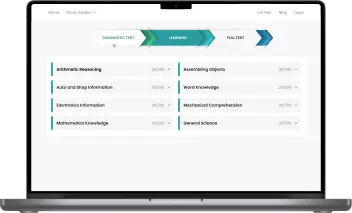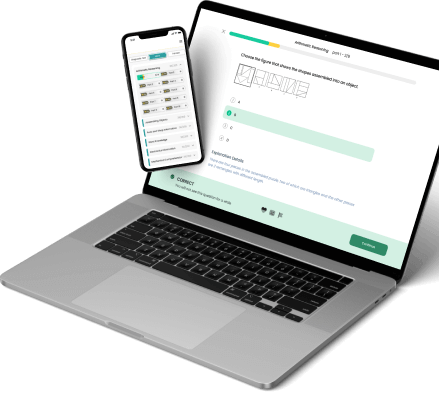Fun & effective DAT practice test tool to pass with flying colors
All-in-one platform with everything you need to ace the DAT on your first attempt
Clear and Thorough Learning Path
Proven DAT 3-step Practice Formula
After our 100,000+ users' success stories, we developed a 3-step strategy to provide you with the most precise and in-depth learning path while minimizing your prep time.DAT Diagnostic Test
First, take this short test and get your detailed report showing your strong and weak areas. Save your time by concentrating on what is in demand.Learning
With quick, bite-sized learning techniques and a detailed study guide for each DAT section, you can really strengthen your weaknesses (from step 1) and boost your scores.DAT Full Test
The last step for your preparation is taking our full DAT practice tests and seeing how far you've come since the beginning. Repeat the 3-step formula until you are satisfied with your results!Ready to start?
Thousands of DAT users already accomplished their goals.NOW it’s your turn!

What You Get

All-in-one platform
A complete DAT Prep Platform, including a diagnostic test, detailed study guides for all topics, practice questions with step-by-step explanations, and various full simulator tests.
Questions nearly identical to those in the real DAT test
All questions are categorized into the specific sections as on the real DAT: Same format & same difficulty!
Best for the busy
Easily & quickly grasp all the knowledge with our unique learning technique. And you can learn anytime, anywhere on any devices, even with a few free minutes.
Practice while having fun
Learn and play! Complete round-by-round to reach your daily achievement and make progress on your learning journey!Featured on















What our users are saying
Over 50,000 aspiring American candidates use DAT monthlyWhen it comes to the dental industry, one of the most significant actions you can take toward achieving your long-term objective of practicing dentistry is to take the Dental Admissions Test (DAT). Since the DAT is one of the variables that dental schools take into consideration when making admissions choices, taking it will help evaluate whether or not you have the knowledge and abilities essential to be accepted into dental school.
When you are getting ready for this test, there are a few pieces of information that are connected to it that you should be aware of. These pieces of information may be helpful for you as you study and get ready for this test. In this study guide, we will provide you with the knowledge you want to ace the DAT.
What is the DAT?
The Dental Admission Exam, sometimes known simply as the DAT, is a standardized test consisting of multiple-choice questions that are administered to prospective dental school students throughout the United States and Canada. The DAT is a standardized test that is completed on a computer and may be taken on almost any day of the year. After the preliminary application has been submitted to the American Dental Association (ADA), candidates have the opportunity to take examinations at any of the Prometric testing centers located throughout the United States.
The Dental Admissions Test (DAT) score, in conjunction with your academic record, is one of the primary factors that determine whether or not you have the necessary intellectual foundation to pursue a successful career in dentistry. Therefore, a high score on the DAT will have a favorable influence on the admission process for dental programs that you are interested in attending.
The purpose of the DAT is to offer dental schools standardized metrics that can be used to compare the credentials of potential students. The exam evaluates a candidate's overall academic skills as well as their comprehension of scientific content and their perceptual aptitude. The test is administered only via the use of a computer and consists of a battery of 4 separate assessments: Survey of Natural Sciences, Perceptual Ability, Reading Comprehension, and Quantitative Reasoning.
When you take the DAT, you will be responsible for the $475 non-refundable exam cost.
DAT Testing Format
Regarding the format of the exam, what should you know about the DAT? On the DAT test, every question is a multiple-choice question, and it is all completed on the computer. You are free to take the DAT whenever and wherever you like since it is administered at Prometric testing sites all across the country (within the six-month testing period).
In all, there are 4 different parts to the DAT; in addition, there is a break period, an optional piece, and a tutorial that comes right at the beginning of the test. The test would run for four hours and fifteen minutes if it did not include any more portions, but with those sections included, the total duration would be five hours. Let's have a look at the breakdown of the sections and the time:
|
Section |
Time Allotted |
|
Optional Tutorial |
15 minutes |
|
Survey of Natural Sciences |
90 minutes |
|
Perceptual Ability Test |
60 minutes |
|
Optional Break |
15 minutes |
|
Reading Comprehension Test |
60 minutes |
|
Quantitative Reading Test |
45 minutes |
|
Optional Post Test Survey |
15 minutes |
Now that you have a better concept of the structure of the DAT test, the four parts, and the time given for each, let's have a look at the total amount of questions and the basic subject areas that are evaluated.
|
Section |
Questions |
General Topics |
Survey of Natural Sciences |
100 |
Biology (40 items) General Chemistry (30 items) Organic Chemistry (30 items) |
Perceptual Ability Test |
90 |
Contains six subtests: Apertures View Recognition Angle Discrimination Paper Folding Cube Counting 3D Form Development |
|
Reading Comprehension Test |
50 |
A variety of topics are covered to test reading comprehension |
Quantitative Reading Test |
40 |
Mathematics- Algebra, Geometry, Trigonometry, Probability, Statistics, Numeric Calculations and Conversions |
Please refer to the part of the DAT Examinee Guide under "Test Substance and Test Preparation Materials" for information that is even more explicit about the content of the DAT.
What Is Covered on the DAT Exam?
Survey of the Natural Sciences
Students are given one hundred multiple-choice questions to answer for the Survey of the Natural Sciences exam. These questions are broken up into three categories: biology, general chemistry, and organic chemistry. The student's knowledge of cell, molecular, and developmental biology, as well as evolution genetics, and biological systems, are evaluated in the biology component of the exam.
The topics of redox processes, stoichiometry, the characteristics of elements and substances including liquids and solutions, atomic structure, and thermodynamics should be reviewed by students in preparation for the general chemistry portion. In the organic chemistry section of the exam, you will be tested on your knowledge of a wide range of atomic and molecular-level interactions.
Perceptual Ability
The pupils' capacity for spatial thinking is evaluated using a test that consists of ninety questions and is divided into six different areas. In the keyhole exam, students are shown a three-dimensional object and asked to choose one of five holes that the item might potentially pass through.
Students are given two out of the three possible views of an item on the top-front-end exam, and it is their job to figure out which view is missing. In the segment on counting cubes, the students are presented with a structure made out of cubes and asked to pretend that the structure is entirely painted everywhere other than on its base. The next step for the pupils is to count the number of cubes that have two, three, or four sides painted. Students will be asked to arrange a set of angles according to size, starting with the lowest and working their way up to the largest.
The last questions, which test students' ability to picture how a certain piece of paper might appear when folded and unfolded, are those about hole punching and pattern folding respectively.
Reading Comprehension
The Reading Comprehension portion of the DAT consists of fifty questions and is designed to evaluate students' ability to comprehend and critically evaluate scientific writing. The examination comprises many passages of scientific writing, each of which is around 500 words long, and anything from six to eight questions about each piece.
Students may be asked to choose the most appropriate title for the piece, to choose a thesis, or to draw an inference, or they may simply be tested on their ability to comprehend the material presented in the passage.
Quantitative Reasoning
Students are provided with an on-screen 4-function calculator to use while answering the forty questions that make up the Quantitative Reasoning component of the exam. Although the exam does not feature questions based on calculus, the questions cover a wide range of mathematical topics appropriate for college students. The fundamentals of algebra and computation, including scientific notation and unit conversions, should be reviewed by the students. Statistics should also be covered.
The portions of the math exam that include geometry and trigonometry are the most difficult. Approximately half of the questions are conventional mathematical tasks, such as asking pupils to solve equations or simplify expressions. The remaining questions use word problems.
DAT Scoring Structure
Immediately after the end of the test, the student will get 8 standard scores ranging from 1 to 30 based on their performance on the examination. Perceptual ability, reading comprehension, quantitative reasoning, biology, general chemistry, and organic chemistry are the first 6 results that come straight from the exam. The remaining 2 scores that are stated are breakdowns of the previous 6. The Academic Average is calculated by taking the average of 5 scores and rounding them up to the nearest whole number. These five scores are quantitative reasoning, reading comprehension, biology, general chemistry, and organic chemistry.
The standard score for the Total Science examination is determined by adding together the results of all 100 questions from the biology, general chemistry, and organic chemistry exams. Dental schools usually provide applicants with a summary of their results by providing the academic, science, and perceptual ability scores that are typical of students who enroll in their courses.
The average score for each portion that is assessed is set at 17, except the reading comprehension part, which has an average score of 19 in that section. The number of standard deviations in fractions that are represented by scores above and below this threshold.
In most cases, a score of 19 or above is required for admission to dental school in the United States. There are a variety of viewpoints on the order in which the parts should be prioritized, and the PAT or reading comprehension might be considered the most important part of the exam, or it could be omitted entirely. The PAT in particular is regarded as a threshold score the vast majority of the time, and as a result, it is the sole score that is not included in the academic average; the threshold ranges between 16 and 18.
How to Interpret the DAT Score?
On the DAT, you get one point for each question to the raw score that is successfully answered. Scaled scores are produced after which raw results are sent to dental schools. These top choices, which have a range from 1 to 30, provide dental schools the data they need to properly compare your competence and skill set to all other test takers for making admission choices.
There will be a total of 8 score reports given to candidates. There are three of these: (1) a total science score derived from all of the questions in the Survey of Natural Science section; (2) an Academic Average (AA), which is the average score for Biology, General Chemistry, Organic Chemistry, Reading Comprehension, and Quantitative Reasoning; and (3) 6 different segment scores.
The 50th percentile scaled score for the majority of the DAT components is 17, which is the average score. Accordingly, if you get a score of 17, you will do better than 50% of other test-takers. In the 75th percentile, when a score of 19 or 20 puts you in front of three-quarters of DAT test participants, scoring becomes considerably more difficult. The top 2% of test takers will score in the 98th percentile or above, which corresponds to a range of 22 to 23, or higher.
Although the average section score on the DAT is 17, it's crucial to remember that most dental schools demand a score of 19 on the Academic Average in order to accept applicants. Dental schools will utilize your total undergraduate GPA and your DAT Academic Average as their key criteria for admission. An AA of 23.2 or 23.8 is required for more strict admissions at elite institutions such as the UCLA School of Dentistry and Harvard School of Dental Medicine.
Is the DAT Hard?
In a nutshell, the answer is "yes," the DAT is one of the most challenging standardized tests.
The duration of the DAT, in addition to the extensive breadth of topics it covers, are the two primary factors that contribute to the difficulty of the exam. The test will cover a wide variety of topics and will include a substantial quantity of knowledge. It is a 6-part test that lasts for a total of four hours and 15 minutes, excluding the pauses that are encouraged to take between parts. That may seem like a long time, but many who have taken the DAT in the past have reported that time flies by, forcing them to take educated guesses on certain questions so they can complete the test on time.
Some students claim that they were able to receive a score that was sufficient for admission with one month of study time or less, while other students claim that they were able to receive a score that was optimal for admission with several months of study time. Many students report that they need to study for several months to achieve optimal scores.
Many study guides and other preparatory resources suggest that the typical student devotes between 200-250 hours to their preparation over 8-12 weeks. You may make your study schedule by using these rough estimates and basing them on the number of questions and scoring weight of the sections, as well as your own prior experience and familiarity with each topic.
DAT Practice Test features
- Free Practice Questions: 1000+ FREE DAT practice questions with detailed explanations are available for all of the required skills. All you need to pass your recruitment test is available here.
- DAT Practice Tests Based On Real Tests: Same number of questions, same time limits, same structure. The exam simulators let you familiarize yourself with the test format and get totally ready for the real one.
- No Sign-Up Or Login Required: All of your progress is saved without an account, even if you close your browser. But login can sync your data between web and mobile applications.
- Gamification: The learning process will be divided into small milestones. Let’s make your studying exciting as if you were in some interesting games.
- Personal Study Plan: Just enter your DAT test date, and a study plan will be set up for you. A clear schedule will surely exceed your expectations and get you the best preparation for the reading shot.
- 3 Interesting Test Modes: 3 different test modes with increased difficulty levels let you experience the test in various ways.
- Dark Mode: Experience a dark theme that is more friendly to your eyes, and get a whole new and marvelous experience.
- DAT Test Bank: 3 features: Weak/ Medium/ Strong questions help you clearly determine which area you should pay more attention to.
Which is the Hardest DAT Section?
The majority of students who take the DAT agree that, despite the inherently challenging nature of the chemistry content, the biology component is by far the most challenging to prepare for. This is simply due to the vast quantity of information that may be tested during the biology section.
Some people believe that the section on quantitative reasoning is the most challenging because it is the very last section of the exam. By the time you get to that point, you are likely to be mentally and physically exhausted from all of the questions on chemistry, biology, and perceptual ability that you have already answered. Examinees who have taken the DAT in the past have echoed the sentiment that they were frustrated by their inability to finish the Quantitative Reasoning component within the given 45 minutes.
DAT Availability
Exam centers run by Prometric testing facilities are the only places that provide access to the DAT throughout the whole year. Knowing that the DAT is offered at testing centers around the country at all times of the year is one of the most beneficial aspects of getting ready to take the exam.
Your registration to sit for the DAT will be approved by the ADA, at which time you will get an email from Prometric instructing you to visit their website or call them to book an appointment for the exam. Because there are close to 500 accredited Prometric testing facilities throughout the United States, its territories, and Canada, you should be able to find one that is located within a reasonable distance from your home.
Candidates are required to get a Dental Personal Identification Number (DENTPIN®) from the American Dental Association before they may register for the DAT. This number must be presented at the time of registration. When you are organizing your calendar, be sure that you arrange your testing appointment 60–90 days in advance of the day that you want to take the exam. After you have enrolled, your registration will be active for a maximum of half a year.
The majority of Prometric testing facilities provide appointments for applicants who need to take the test in the evening or on the weekend. This is done to assist candidates who may have full-time jobs or who may have obligations to their families. The computer-based nature of the exam allows for quite a bit of leeway in terms of when it may be taken.
You are permitted to repeat the examination up to a maximum of three times per year, as stated by the American Dental Association (ADA), provided that you wait 90 days following your most recent attempt. Candidates who have attempted the DAT more than three times will be required to get permission from the ADA before retaking the exam. You may be granted permission to retake the examination once per calendar year if you are eligible for it.
How Many Times Can You Take The DAT?
There is no restriction on the number of times you may take the DAT; you are not restricted to just one try. You are permitted to take the Dental Admission Test (DAT) a total of three times if you are interested in applying to dental school. It is possible to retake the DAT either because your score was too low to get into the school of your choice or because you just want to see if you can better your test results.
Applicants who wish to retake the exam should be aware that to do so, they are required to wait a minimum of ninety days from the date of their most recent examination attempt before retaking the exam. Additionally, aspirants are required to pay a new application and testing fee for each new testing attempt. Be careful to verify with the dental schools that interest you, since the admissions process is handled differently at each school. This includes the DAT score(s) that dental schools will use when making admissions decisions. The institution to which you have applied could accept the highest of your results, the average of your scores throughout the number of times you've taken the test, or the most recent one.
If you have already used up all three of your opportunities to take the Dental Admission Test (DAT) and are still unhappy with either your score or your potential to enroll in dental school, you may be eligible to petition for and be granted permission to take the test a fourth time. You will need to file an appeal with the American Dental Association to get approval for a fourth try (ADA). The ADA is the only organization that can permit applicants to take the examination more than three times.
Even though you are allowed three tries to pass the DAT, you should approach your preparation and study for the exam as if it were the only time you were going to take it. If you can pass the dental school admissions test the first time around with a respectable score, you shouldn't have any trouble getting in. To the best of your ability, develop and maintain an effective study strategy while also giving your very best effort to prepare for the test. If you do this, the hope is that you will get a good score on the DAT, and you won't have to stress about having to retake the exam.
After all, nobody appreciates having to retake exams or pay for extra expenses associated with taking exams more than once.
Preparation Tips for the DAT Test Day
It is quite natural to feel anxious as the clock ticks down closer and closer to the day of the exam. If you have appropriately prepared yourself, all you need to do is accept these sensations and let them pass on their own. You should give your mind and body at least a day or two of preparation before taking the DAT. Reviewing several flashcards for a couple of minutes might help if you feel especially unprepared; nevertheless, you should make an effort to avoid overstressing your brain by taking practice exams or attempting to learn new information.
On the day of the exam, you should be sure to carry a nutritious snack or two, along with a drink of some kind. This will serve as a good motivation for you to actually take your break. This will provide you with a mental and physical break from the test, as well as an excellent opportunity to free your mind of the information that you have just gone over.
Avoid eating anything high in sugar, such as cereal or doughnuts, during the morning of your test. This will prevent you from experiencing a sugar crash in the middle of the exam. Breaktime snacks are also an important consideration. Breakfast foods that are high in protein or long-lasting carbohydrates, such as eggs and bacon or oatmeal, are both excellent choices. These will provide you with a great deal of energy early in the day, as well as excellent mental sharpness, and they won't cause a huge crash at a time of the day when you need it the least.
One final piece of advice on the day of the exam is to get there early. You will need at least 30 minutes, but closer to 60 to have ample time to check in with the staff, locate an available locker, utilize the restroom, summarize any memos you brought with you, and finally, unwind for a short minute to collect yourself before meeting with the proctor and entering the testing room. This will allow you to approach the DAT with confidence and the ability to succeed.
What to do After the Test?
You've put in a lot of effort, and studied well, and now you've finished the DAT; what comes next? Your turn has come to wait for the results of the test. You will be able to obtain your unofficial results immediately after the test has been completed at the Prometric testing location in your area, so the amount of time spent waiting will be low. The official results, on the other hand, will not be available for viewing until 3-4 weeks following the test and will then be submitted to the institutions in which you have shown interest. These are the colleges and universities that you listed on the DAT application, which you filled out when you registered for the exam.
When it comes to choosing a dental school, having a good score on the Dental Admission Test (DAT) will not only open doors for students but will also enhance the number of possibilities available to them. We hope that this piece of information can be beneficial for you during the process of studying and preparing for the DAT exam.






